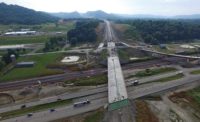The Colorado Section of the American Society of Civil Engineers (ASCE) has released its 2020 Report Card for Colorado’s Infrastructure, giving 14 categories of infrastructure in the state an overall grade of a C-.
The association’s civil engineers graded individual infrastructure categories as follows: aviation (B), bridges (C+), dams (C+), drinking water (C-), energy (C+), hazardous waste (C-), levees (D+), parks (C), rail (B-), roads (C-), schools (D+), solid waste (C-), transit (C-) and wastewater (C-).
Schools received one of the lowest grades (D+), exhibiting needs that far exceed the funding available for necessary replacements, repairs or upgrades. Those add up to a nearly $14 billion funding gap.
In general, Colorado’s transportation network has seen positive jumps since the 2010 report card, according to ASCE, but it faces challenges due to age, weather damage and lack of investment.
The overall condition of Colorado’s bridges (C+) is above average. Of Colorado’s 8,786 bridges, 5.4% are rated structurally deficient, compared to 7.6% nationally, but 15.4% require repairs with an estimated cost of more than $680 million. Environmental hazards such as freeze-thaw, rockfalls and scour have increased the rate of bridge deterioration, making it difficult to protect them against these threats.
While Colorado has some of the costliest maintenance challenges in the country due to the large mountain passes and elevation changes, 44% of roads are in good condition as compared to the national average of 28%.
Over the last 10 years, the Colorado Dept. of Transportation and transit agencies have stretched limited funding to increase capacity of the state’s surface transportation networks. But the ability to sustain these conditions is uncertain, because Colorado’s gas tax has not increased since 1991, and the state is grappling with a growing population and aging assets.
Population growth in the state is causing overuse and wear and tear in Colorado’s drinking water systems and energy grid. The average age of the state’s major drinking water treatment facilities and conveyance pipes is approaching 50 years. With a standard design life of 50 to 60 years, many of the infrastructure components are approaching or have exceeded that range.
While drinking water capacity is currently sufficient, some rural areas are challenged to provide clean water to their constituents due to aging pipelines. A positive note was that water consumption in Colorado is nearly 50% lower than the national average due, in large part, to a successful public education program focusing on water conservation that was implemented in the early 2000s by various water utilities.
Colorado is rapidly transitioning to cleaner sources of energy and produces more than 232,900 energy jobs in the state, but the energy grid faces challenges. For example, the existing transmission and distribution lines were not built to accommodate large amounts of renewable energy, and distribution lines are vulnerable to severe weather, contributing to Coloradans experiencing an average of 2.8 hours of power outages annually.
While this compares favorably to the national average of 5.9 hours per customer per year, each outage can have major impacts on quality of life and productivity. In the near- and long-term, wildfires, heavy winds and floods will put increased stress on the state’s energy infrastructure.
Dams scored about the national average at a ‘C+.’ In Colorado, the number and quality of Emergency Action Plans (EAPs) have significantly increased. Today, approximately 98% of high-hazard-potential dams now have an EAP, putting fewer residents at risk in the event of a dam failure.


